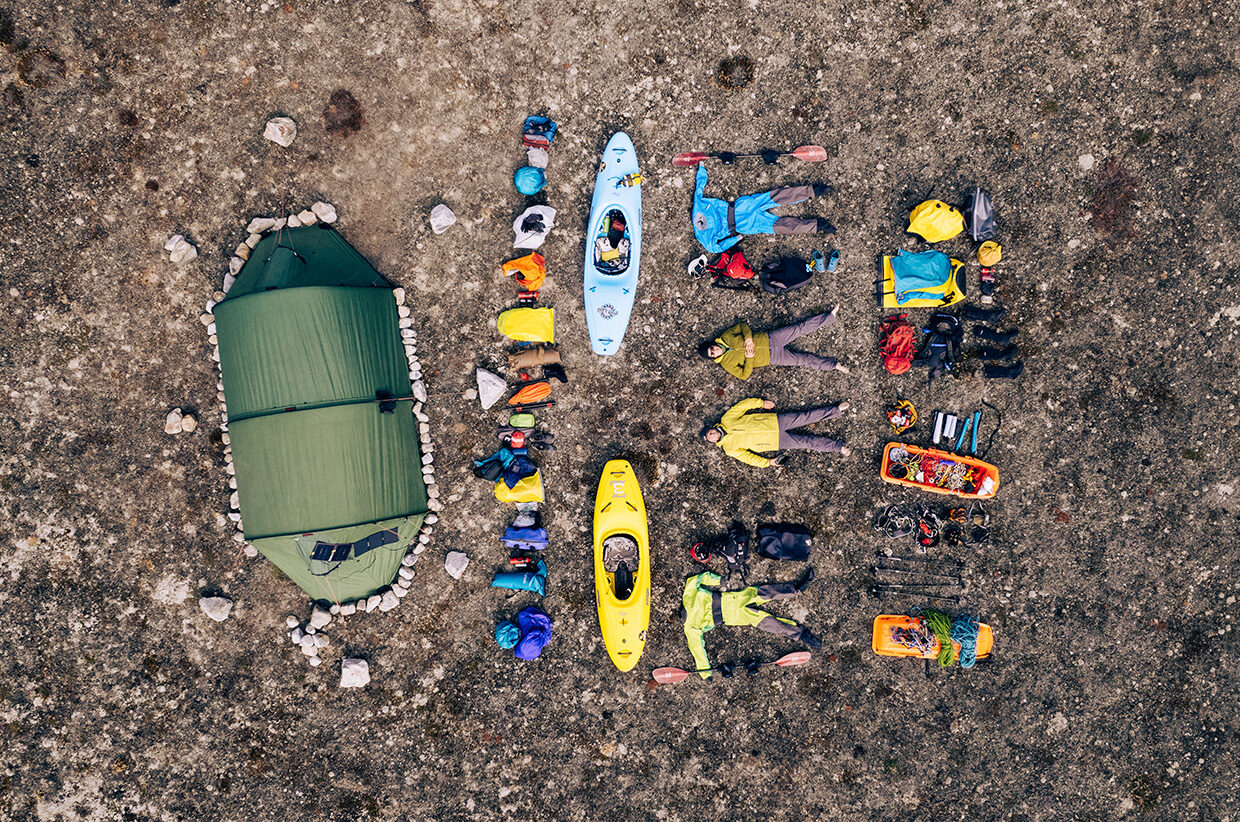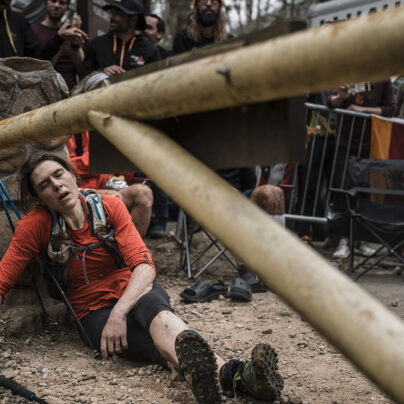45 Days, No Backups
Inspiration
Behind the Scenes on A Baffin Vacation
Interview by Jenny Tough // Film and photography by Sarah McNair-Landry and Erik Boomer
‘I only had one chance to get the shot, and the conditions weren’t great. The spray from the waterfall soaked my cameras and the wind was on the edge for the drone. Not to mention that I was also Boomer’s only safety.’
A Baffin Vacation is a film about Sarah McNair-Landry and Erik Boomer’s impressive 45-day expedition into Inuksuit Fiord on Baffin Island. Sarah and Boomer made the film, which was entirely self shot, in collaboration with post-production aid from Rush Sturges. The multi-sport expedition involved the pair skiing into the remote landscape with climbing and whitewater kayaking equipment, along with their camping gear, food supplies, and entire filming setup to survive completely isolated for over a month. The Sidetracked Creators Tour 2023 opened with their film, and the fun, personable, and truly gnarly portrayal was the perfect starter for an adventurous and creative audience.
Thanks to being on the tour, the Sidetracked team have seen this film enough times to pick up on all of the small details and have the catchy soundtrack stuck in our minds – so we needed to finally get to ask them our burning questions about creating this work.
Jenny Tough: Tell us about the challenges of filming while being in the backcountry for such an extended period of time – and what was on the kit list?
Boomer: Our biggest challenge was keeping our camera kit light – yet still have enough batteries and media for 45 days.
To access Inuksuit Fiord we skied in, hauling all our gear and supplies stuffed into our kayaks and extra sled. We travelled 100km into Inuksuit and set up a small climbing base camp. Once there, we could stash some of our heavier gear and head out light on the climbing and kayaking sections.
We decided to take two DSLR cameras (Fuji and Canon), plus GoPros and a drone. Our tripod was too heavy to make the cut. We had limited media and batteries – which forced us to focus on what we shot. Multiple memory cards totalling about 2TB were our media storage, with no backup until we got home 45 days later.
For battery power we had two 20W solar panels and a 100W Goal Zero battery. The drone took the most power – so we had to be really efficient about when and how long we flew the drone.
On the climbing missions (generally 24 to 48-hour pushes) we had to be as light as possible, so we would just bring the GoPro cameras, and recharge back in base camp.
On the kayaking section we headed out with over two weeks of food and gear. Everything had to fit in our whitewater kayaks, and we had to be able to carry our boats on our shoulder for long distances. So we only brought one camera, the GoPros, and the drone. Our charge kit was too heavy so we only had the batteries we carried.
How did you work around being a full filming team of just two – including being the on-screen stars at the same time?
Sarah: Shooting as a team of two is challenging. It’s hard to capture moments with the two of us together. Luckily Boomer got good at flying the drone while skiing and hiking to get shots of us travelling. And the GoPro was useful to self film the two of us interacting.
On the mountains, one of us was always climbing, while the other was belaying – which meant we relied heavily on the GoPros, either attached to our helmets, or perched on a ledge.
The most challenging moments for me to capture were the two waterfalls that Boomer kayaked. I only had one chance to get the shot, and the conditions weren’t great. The spray from the waterfall soaked my cameras and the wind was on the edge for the drone. Not to mention that I was also Boomer’s only safety.
So, with my throwline bag ready, I launched the drone to get a static drone shot, while also operating the video camera (usually precariously perched on a rock because we had no tripod). Once recording, I would grab one of our smaller cameras to capture stills as well.
Boomer also kayaked the big waterfall twice, giving me another chance to capture stills and video.



Did you go in with a plan for filming? Did you know what the theme of the film was going to be before you started your expedition?
Sarah: We went in with the goal of shooting an adventure film and had a rough shot list. We had never been to Inuksuit Fiord before, and like all good adventures we didn’t really know what to expect or how the expedition would play out.
Our general idea was to create an honest and fun film, totally self shot. I think self shooting creates a very intimate environment – it’s way easier to be natural and honest in front of a camera when it’s Boomer behind the lens, versus a camera crew whom you just met.
Did you film every day, or did some stuff stay just for you?
Boomer: We made it a goal to film something we were excited about every day. On rest or bad-weather days we still made a point to go for a walk and get footage of the landscape, details, timelapse, portraits, and so on.
Even so, we had many moments every day just to ourselves without the camera.
How do you find collaborating with your partner? Do each of you have a role, or is it fully shared?
Boomer: We have our natural roles that we fall into – I come from a photography background, while Sarah comes from a filming background – but we rotated and shared the duties of filming, capturing photos, and being in front of the camera as much as possible.
I love flying the drone, so ended up doing a lot of the drone shots. But oftentimes Sarah found herself flying the drone and filming at the same time while we were kayaking.
We loved the music choice – it was such a great opener for the Creators Tour! How did you select the music?
Sarah: We partnered with our friend Rush Sturges (River Roots Productions) for post-production. Rush is not only an athlete and filmmaker, but also a musician (you can check out his music on Spotify) and did an amazing job at selecting the music for the film.



Did you have to do any supplementary filming once you returned home?
Sarah: We did all the filming and interviews in the field. The interviews were especially hard to motivate and film. Often there was too much wind for sound or it was raining. We didn’t have a tripod, so instead we awkwardly balanced our monopod between gear and rocks as a makeshift tripod.
But we really wanted to capture ourselves in the moment, even if it meant perhaps sacrificing quality at times.
What did you learn on this expedition?
Boomer: I learned a ton about climbing! The sport was so new to us and the place was so big we went straight to the school of hard knocks. With a few more years of climbing experience it is fun to look back at this trip and see how hard we tried.
Sarah: Although we self shot in the field, Boomer and I are lucky to have worked with an amazing team for the post-production of A Baffin Vacation. We couldn’t have done it without Rush Sturges and his amazing team at River Roots. And we’d also like to thank Whitewater, a non-profit organisation dedicated to protecting and promoting access to the active, outdoor lifestyle.
Read A Baffin Vacation (as previously published in Sidetracked Volume 24) here.
A Film by Sarah McNair-Landry and Erik Boomer // @sarahmcnairlandry // @erikboomer
Presented by Whitewater // @usnwc // @riverrootsproductions
Produced by Erik Boomer, Sarah McNair-Landry, and Rush Sturges // @rushsturges
Interview by Jenny Tough // @jennytough




